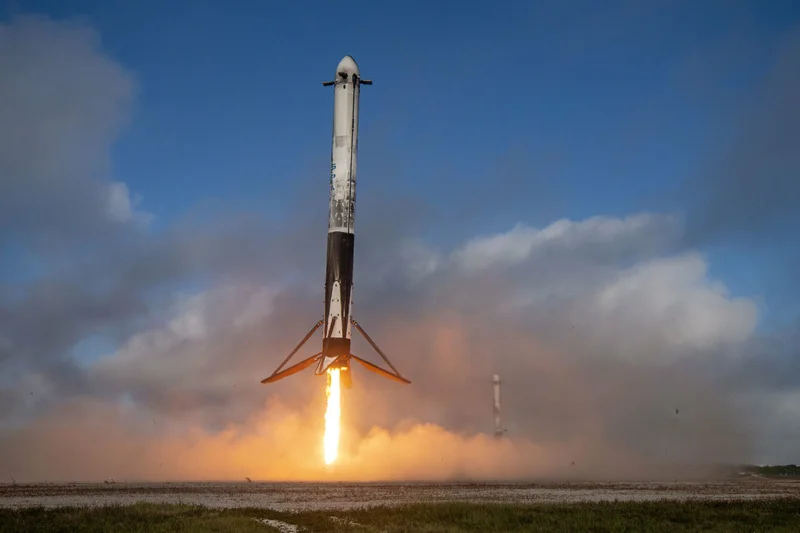A Temporary Setback or a Sign of Things to Come?
The FAA's decision to restrict commercial space launches to nighttime hours—between 10 p.m. and 6 a.m. local time, starting November 10, 2025—is being framed as a temporary measure. The stated reason: strains on the air traffic control system exacerbated by the ongoing government shutdown (which, let's be clear, is a political failure, not a force of nature). But is this a one-off, or does it reveal a deeper vulnerability in the increasingly crowded space launch market?
The immediate impact is clear. SpaceX, with its planned Falcon 9 launch of Starlink satellites slated for the evening of November 10th, is directly affected. So are the three other Falcon 9 launches scheduled within the following week. Blue Origin dodged a bullet, apparently, with its New Glenn launch planned for the afternoon of November 9th. ULA's Atlas 5 launch might squeeze in if they can fix their valve problems and shorten the launch window.
The FAA's order also includes "other operational reductions" on the National Airspace System, primarily focused on reducing commercial flights at 40 major airports by up to 10%. Transportation Secretary Duffy (who is also acting as NASA administrator – a potential conflict of interest?) cites high traffic as the reason. Rocket Lab, conveniently, claims minimal impact due to their New Zealand launch site, which is unaffected.
But let's look at the numbers. The government shutdown has led to unpaid air traffic controllers, increased absenteeism, and hours-long delays for commercial flights. The FAA expects to roll back these restrictions once funding is restored. But here's the rub: even without a government shutdown, the airspace is becoming increasingly congested. The rapid proliferation of commercial space launches, driven by companies like SpaceX, is adding another layer of complexity to an already strained system. FAA to restrict commercial launches during government shutdown - SpaceNews
And this is the part of the situation I find genuinely puzzling. While the FAA frames this as a response to the shutdown, the underlying problem – a system struggling to accommodate both commercial aviation and a burgeoning space industry – isn't going away. The FAA order gives them flexibility to modify or remove provisions, which is bureaucratic-speak for "we're making this up as we go along."
Steve Dunn reported seeing re-entering space debris east of KSC on Nov. 8, with sonic booms heard shortly after. Steve Bachman's son even captured a video from Jacksonville Beach. This anecdotal evidence (while not statistically significant) points to the growing public awareness – and potential concern – surrounding space activities. Are we properly accounting for the risks and externalities associated with this rapid expansion?
The Real Cost of "Flexibility"
The FAA’s claim of “flexibility” is, in reality, a lack of long-term planning. They're reacting to immediate crises rather than proactively managing the airspace. This temporary fix—restricting launches to nighttime—is akin to treating a symptom while ignoring the disease. What happens when the number of launches doubles or triples in the next few years? Are we going to have entirely nocturnal space operations?

SpaceX, for its part, launched a batch of Starlink satellites on November 9th, using Falcon 9 booster B1069, which made its 28th flight. The booster landed successfully on the drone ship ‘A Shortfall of Gravitas.’ SpaceX intends to deploy 29 Starlink V2 Mini Optimized satellites. SpaceX launches Sunday Starlink mission following Saturday scrub - Spaceflight Now They also announced five more Starlink missions between Nov. 10 and Nov. 19. The sheer volume of launches is staggering and highlights the scale of the challenge facing the FAA.
The 45th Weather Squadron forecast a 95 percent chance for favorable weather at liftoff on Sunday, citing a small chance for interference from cumulus clouds. It’s good that they are paying attention to the weather, but what about the other risks?
Here’s a thought leap: How accurate are these risk assessments, really? Who is independently auditing the FAA's and the launch providers' safety protocols? The public is relying on these agencies to ensure safety, but the current situation raises questions about their capacity to handle the increasing workload.
A Crisis Waiting to Happen
The FAA's temporary restrictions are a canary in the coal mine. They expose a fundamental weakness in our approach to managing the space industry. While innovation is crucial, it shouldn't come at the expense of safety and efficiency in the national airspace. This isn't just about inconvenience; it's about the potential for a real disaster.
The Data Gap is Growing
The shutdown ends, the restrictions are lifted, and everyone breathes a sigh of relief. But the underlying problem remains, unaddressed. What metrics are being used to measure the actual strain on the air traffic control system? Where is the publicly available data on near-miss incidents or increased controller workload? The lack of transparency is concerning.
A Wake-Up Call for Regulators
The FAA's actions are not a solution; they're a Band-Aid. The real question is whether we're willing to invest in the infrastructure and oversight needed to support a sustainable and safe space industry. And I'm not just talking about money; I'm talking about a fundamental shift in mindset.
We're Flying Blind
The FAA's temporary restrictions are a symptom of a larger systemic issue: a regulatory framework that's struggling to keep pace with the rapid growth of the commercial space industry.
